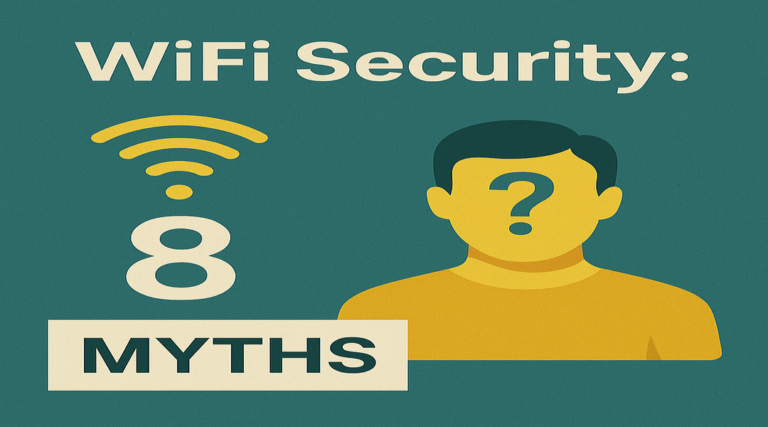WiFi Security: 10 Best Practices for Safe Browsing
WiFi security is no longer optional in today’s interconnected world where our most sensitive information travels through invisible airwaves. Every day, countless networks fall victim to cyberattacks that could have been prevented with basic security measures. Would you believe that research shows nearly 41% of all WiFi networks are vulnerable to exploitation through simple hacking techniques? That’s almost half of all wireless networks operating with insufficient protection.
Think about it this way: leaving your WiFi network unsecured is like leaving your front door wide open with a sign saying “valuables inside” while you’re away on vacation. Just as you wouldn’t leave your physical home unprotected, your digital domain deserves the same level of security consideration.
A properly secured WiFi network doesn’t just protect your personal information from theft; it also ensures your connection remains fast and reliable by preventing unauthorized bandwidth usage. It protects your identity, your finances, and even your reputation from potential compromise.
The good news? Securing your WiFi doesn’t require advanced technical knowledge or expensive equipment. With just a few simple adjustments to your settings and habits, you can dramatically improve your wireless security and browse with confidence. Let’s explore the most effective ways to lock down your network and keep digital intruders at bay.
Table of Contents
What is WiFi Security?
Ever wondered what actually happens behind the scenes when you connect to a wireless network? WiFi security encompasses all the protocols, settings, and practices designed to protect your network from unauthorized access and data interception. It’s essentially your digital force field, creating a protective barrier between your sensitive information and those who might want to exploit it.
Here’s something most people don’t realize: hackers often describe unsecured WiFi as “low-hanging fruit” because it requires minimal effort to compromise. They use readily available tools that can crack basic security measures in minutes, often while sitting in a nearby car or coffee shop without anyone noticing.
Don’t let your network become an easy target! By understanding and implementing proper WiFi security measures, you can make your digital environment significantly more resilient against increasingly sophisticated cyber threats.
Why You Should Secure Your WiFi Network
Prevent Unauthorized Access and Bandwidth Theft
When your network lacks proper security, neighbors and nearby strangers can easily “borrow” your internet connection without permission. This unauthorized access doesn’t just slow down your browsing experience—it can potentially lead to legal complications if someone uses your network for illegal activities. Since the traffic originates from your IP address, any malicious actions could be traced back to you, creating a legal nightmare that could have been easily prevented.
Protect Personal and Financial Information
Unsecured networks leave everything transmitted across them vulnerable to interception. This includes banking passwords, credit card details, private emails, and sensitive documents. Cybercriminals use techniques like “packet sniffing” to capture data as it travels between your devices and your router. With this information, they can commit identity theft, financial fraud, and serious privacy violations that could impact your life for years to come.
Improve Network Performance and Reliability
A secured network is typically a better performing network. When unauthorized users connect to your WiFi, they consume your bandwidth, resulting in slower speeds, buffering videos, lagging video calls, and frustrating disconnections during important online activities. Proper security measures ensure that only your authorized devices get access to the bandwidth you’re paying for.
The contrast between weak and strong WiFi security is dramatic: weak security (such as using outdated protocols or simple passwords) can be breached in minutes, while robust security measures can keep attackers at bay indefinitely. Take a moment today to review your WiFi security settings—your digital well-being depends on it.
How to Secure Your WiFi Network
Quick Overview
Securing your WiFi network is surprisingly straightforward yet immensely valuable. The process primarily involves adjusting your router’s settings to implement stronger protections and developing better security habits. These simple changes transform your network from an easy target into a formidable challenge that discourages all but the most determined attackers.
The cornerstone elements of WiFi security include strong, unique passwords; modern encryption protocols; regular firmware updates; and careful management of connected devices. By addressing these fundamentals, you can eliminate the vast majority of potential security vulnerabilities.
Key Steps to Strengthen WiFi Security
1. Change Default Router Credentials
Most routers ship with factory-set usernames and passwords like “admin/admin” or “admin/password.” These default credentials are widely known and documented online, making them the first thing attackers try when attempting to access your network. Changing these default login details is your first and most critical defense against unauthorized router access.
2. Enable WPA3 or WPA2 Encryption
WiFi security protocols have evolved significantly over time. WPA3 is the newest and most secure standard, offering enhanced encryption and resistance to offline dictionary attacks. If your router doesn’t support WPA3 yet, WPA2 with AES encryption is your next best option. Never use the outdated WEP protocol, which can be cracked with freely available tools in a matter of minutes.
3. Create a Strong Network Password
Your WiFi password should be at least 12 characters long and include a mix of uppercase letters, lowercase letters, numbers, and special characters. Avoid using obvious information like your address, pet names, or birthdays. Consider using a passphrase—a string of random words—which can be both memorable for you and difficult for others to guess.
4. Disable WPS and Remote Management
WiFi Protected Setup (WPS) was designed to simplify the process of connecting devices to your network, but it contains vulnerabilities that can be exploited. Similarly, remote management features that allow access to your router from outside your network create unnecessary security risks. Disable both features unless you have a specific need for them.
5. Hide Your Network SSID (Optional)
While not foolproof, hiding your network name (SSID) prevents it from appearing in the list of available networks on nearby devices. This won’t stop determined attackers but adds an extra obstacle for casual network browsers. Keep in mind that some older devices may have trouble connecting to hidden networks.
6. Set Up a Guest Network
Many modern routers support creating a separate network for visitors. This allows guests to access the internet without connecting to your primary network where your personal devices and sensitive information reside. Always use a different password for your guest network and consider enabling features that isolate guest devices from each other.
7. Update Router Firmware Regularly
Router manufacturers frequently release firmware updates that patch security vulnerabilities. Check for these updates every few months or enable automatic updates if your router supports this feature. This simple maintenance task significantly reduces your exposure to new and emerging threats.
8. Enable Network Firewall
Most routers include built-in firewall capabilities that can be enabled through your router’s administrative interface. These firewalls monitor incoming and outgoing traffic, blocking suspicious connections before they can reach your devices. For maximum protection, use your router’s firewall in conjunction with software firewalls on your individual devices.
9. Implement Access Scheduling
If you don’t need WiFi access 24/7, consider setting up access scheduling through your router. This feature allows you to automatically disable your wireless network during specified hours, such as when you’re asleep or away from home. This reduces the window of opportunity for potential attackers.
10. Disable Unused Features and Services
Modern routers come with numerous features that you may never use, such as UPnP (Universal Plug and Play), DLNA media serving, or printer sharing. Each active service potentially introduces new vulnerabilities. Review your router settings and disable any services you don’t actively use.
Step-by-Step Guide to Securing Your WiFi
- Access your router’s admin panel: Open a web browser and enter your router’s IP address in the address bar (commonly 192.168.0.1 or 192.168.1.1). Log in with the default credentials if you haven’t changed them yet.
- Update firmware immediately: Before making any other changes, check for firmware updates. This ensures you’re working with the most secure version of your router’s software.
- Change admin credentials: Navigate to the Administration or System settings. Create a strong, unique password for accessing your router’s settings. Store this password securely, as recovering it typically requires resetting your router.
- Configure wireless security settings: Find the Wireless or Security section. Select WPA3 if available (or WPA2-Personal with AES) and create a strong WiFi password that differs from your admin password.
- Disable unnecessary features: Turn off WPS, UPnP, Remote Management, and any other services you don’t use in the Advanced Settings section.
- Set up a guest network: If your router supports it, create a separate network for visitors with a different password and limited access privileges.
- Consider MAC address filtering: For extra security, enable MAC address filtering and add the specific devices you want to allow on your network.
- Enable the firewall: Activate your router’s built-in firewall features and set them to an appropriate security level (medium is generally a good balance).
- Save settings and restart: After making these changes, save your settings and restart your router to ensure all changes take effect properly.
- Document your settings: Keep a secure record of your new passwords and security configurations in case you need to reference them in the future.
Common WiFi Security Threats and How to Avoid Them
Man-in-the-Middle (MITM) Attacks
In MITM attacks, hackers position themselves between you and your connection point, intercepting and potentially altering the communication between you and websites or services you trust. These sophisticated attacks enable criminals to capture sensitive information like login credentials and banking details.
Prevention: Always use encrypted connections (look for HTTPS in website URLs). Consider using a VPN for an additional layer of encryption, especially on public networks. Keep your devices and browsers updated to protect against known vulnerabilities that enable these attacks.
WiFi Eavesdropping and Packet Sniffing
Attackers can use specialized software to capture and analyze data packets traveling over unsecured or poorly secured WiFi networks. This allows them to view unencrypted information passing between your devices and the internet.
Prevention: Ensure your network uses strong encryption (WPA3 or WPA2). Avoid accessing sensitive accounts or sharing personal information when connected to public networks. Use encrypted messaging apps and secure websites (HTTPS) for confidential communications.
Evil Twin Attacks
Cybercriminals can create counterfeit WiFi access points that mimic legitimate networks, tricking users into connecting to the malicious network instead of the authentic one. Once connected, all your traffic routes through the attacker’s device.
Prevention: Verify network names carefully, especially in public places. When possible, use your mobile data instead of public WiFi for sensitive transactions. Consider using a trusted VPN service as an additional security layer.
Router Malware and Firmware Exploits
Attackers can compromise routers through malware or by exploiting vulnerabilities in outdated firmware. This allows them to redirect your traffic, change DNS settings, or monitor your online activities.
Prevention: Regularly update your router’s firmware. Use trusted DNS servers like Google (8.8.8.8) or Cloudflare (1.1.1.1) instead of your ISP’s default servers. Periodically reset your router and reconfigure security settings if you suspect compromise.
WiFi Security vs. Public Networks
Your home WiFi network, when properly secured, offers substantially more protection than public hotspots in coffee shops, hotels, airports, and other public spaces. The fundamental difference lies in control—you manage your home network’s security settings, while public networks prioritize easy access over security.
Public WiFi networks present elevated risks because:
- They often use minimal or no encryption
- Multiple unknown users connect to the same network
- Network administrators may prioritize convenience over security
- Attackers specifically target these high-traffic environments
When using public WiFi, always assume someone could be monitoring your traffic. Essential precautions include:
- Using a reputable VPN service to encrypt all your internet traffic
- Avoiding accessing sensitive accounts like banking or email
- Disabling automatic WiFi connections to prevent joining networks without your knowledge
- Verifying you’re connecting to the legitimate network by confirming the exact name with staff
- Enabling your device’s firewall for additional protection
- Using your phone’s cellular data connection for sensitive transactions
Remember that even with these precautions, public WiFi should never be considered completely secure for sensitive activities. The safest approach is to use your phone’s hotspot feature or a dedicated mobile hotspot when you need a trusted connection away from home.
Advanced Tips for Ultimate WiFi Security
Implement MAC Address Filtering
Every network device has a unique identifier called a MAC address. Your router can be configured to only permit connections from devices with specific MAC addresses, essentially creating a whitelist of trusted devices. While sophisticated attackers can “spoof” MAC addresses, this measure deters casual intruders and adds another security layer.
To implement this:
- Find the “MAC Filtering” or “Access Control” section in your router settings
- Enable the feature and set it to “Allow” mode
- Add the MAC addresses of all your trusted devices
- Save the configuration
Deploy Enterprise-Grade Security Appliances
For business environments or users with exceptional security requirements, consider dedicated security appliances like the SonicWave 224W, Fortigate 40F WiFi, or Sophos Wireless Access Point. These devices offer advanced features including intrusion prevention, content filtering, and comprehensive threat analytics beyond what consumer routers provide.
Utilize Router Firewall Protection
Most routers include built-in firewall capabilities that can block suspicious incoming connections. Unlike software firewalls that protect individual devices, router firewalls shield your entire network. For maximum protection:
- Enable your router’s SPI (Stateful Packet Inspection) firewall
- Configure the security level according to your needs
- Consider blocking unnecessary incoming ports
- Use both your router firewall AND device firewalls for layered protection
Set Up Two-Factor Authentication for Router Access
Some newer router models support two-factor authentication (2FA) for admin access, requiring both your password and a verification code sent to your phone or email. This significantly increases security by ensuring that even if your password is compromised, attackers still can’t access your router settings without the second authentication factor.
Monitor Connected Devices Regularly
Periodically checking which devices are connected to your network can help you identify unauthorized users. Most modern routers offer this functionality through their admin interface or companion apps. Make it a habit to:
- Review connected devices weekly
- Verify each device against your known devices
- Investigate any unrecognized connections immediately
- Change your WiFi password if you discover unknown devices
Consider Network Segmentation
For advanced users, creating separate network segments (VLANs) provides additional security by isolating devices from each other. This is particularly useful for separating potentially vulnerable IoT devices from computers containing sensitive information. If one segment is compromised, the others remain protected.
Final Thoughts: Is Your WiFi Secure?
In our increasingly connected world, WiFi security isn’t just a technical consideration—it’s an essential component of protecting your digital identity, privacy, and financial well-being. The security measures you implement directly impact your vulnerability to a wide range of cyber threats, from casual bandwidth theft to sophisticated identity fraud.
Use this quick checklist to evaluate your current WiFi security posture:
- [ ] Using WPA3 or WPA2 encryption with AES (not WEP or open networks)
- [ ] Router firmware updated within the last six months
- [ ] Complex, unique passwords for both WiFi access and router administration
- [ ] WPS and remote management disabled
- [ ] Guest network configured for visitors
- [ ] Network firewall enabled
- [ ] Connected devices regularly monitored
- [ ] Default DNS servers replaced with secure alternatives
- [ ] Unused router services and features disabled
- [ ] VPN used when additional security is needed
If you couldn’t check every box, take time today to address those gaps in your WiFi security. The few minutes you spend now could save you countless hours dealing with the aftermath of a security breach.
Remember that WiFi security isn’t a one-time setup but an ongoing practice. Technology evolves, new vulnerabilities are discovered, and attack methods become more sophisticated. By staying informed about WiFi security protocols and best practices, you ensure that your digital life remains protected against current and emerging threats.
The peace of mind that comes from knowing your network is secure is invaluable. Take action today to protect what matters most—your digital privacy and security.
FAQ: WiFi Security Essentials
What is the difference between WiFi security types like WPA, WPA2, and WPA3?
WiFi security protocols have evolved significantly over time. WPA (WiFi Protected Access) was an improvement over the highly vulnerable WEP standard. WPA2 introduced stronger AES encryption and is still widely used. WPA3, the latest standard, offers the strongest protection with improved encryption, protection against brute force attacks, and better security for public networks. Whenever possible, use WPA3 for maximum security.
How do WiFi security protocols protect my network?
WiFi security protocols like WPA2 and WPA3 encrypt the data transmitted between your devices and your router. This encryption scrambles the information so that even if hackers intercept your data packets, they cannot read the contents without the encryption key. Different protocols use different encryption methods, with newer standards providing stronger protection against various attack techniques.
What security appliances can enhance my WiFi protection?
For advanced protection beyond standard router capabilities, devices like the SonicWave 224W, Fortigate 40F WiFi, or Sophos Wireless Access Points offer enterprise-grade security features. These appliances provide comprehensive protection including intrusion prevention, content filtering, and advanced threat detection. While more expensive than consumer routers, they’re worth considering for small businesses or individuals with high security requirements.
Is my WiFi safe if I just use a strong password?
While a strong password is essential, it’s just one component of WiFi security. Complete protection requires using modern encryption (WPA2/WPA3), keeping firmware updated, disabling vulnerable features like WPS, and monitoring network access. Think of WiFi security as a multi-layered approach where each measure strengthens your overall protection.
What should I look for in a WiFi security app?
A good WiFi security app should offer network scanning to detect vulnerabilities, connected device monitoring, notification of unauthorized access attempts, and verification of encryption standards. Some popular options include WiFi Analyzer, Fing, and WiFi Guard. These apps can help identify security gaps and monitor your network for suspicious activity.
How can I test my WiFi security?
You can test your WiFi security by using network scanning tools (with caution and only on networks you own), checking your router’s security settings against current best practices, and verifying which devices are connected to your network. Several online tools can also check if your router has known vulnerabilities based on its model and firmware version.
Are WiFi security cameras like V380 Pro secure?
WiFi security cameras, including models like the V380 Pro WiFi Security Camera, can present security risks if not properly configured. Always change default passwords, update firmware regularly, use two-factor authentication if available, and consider placing cameras on a separate network from your main devices. Some cameras have better security features than others, so research before purchasing.
What WiFi protection features should I look for in a WiFi 7 router?
When shopping for a WiFi 7 router, look for built-in security features like automatic firmware updates, threat detection, network segregation capabilities (to separate IoT devices from computers), WPA3 support, and secure DNS options. Premium router models may also include subscription security services that provide additional protection against malware and phishing attempts.
How does Frontier handle WiFi security for their customers?
Frontier, like most ISPs, provides routers with basic security features. WiFi security through Frontier typically includes WPA2 encryption and basic firewall protection. However, for optimal security, consider enhancing these default settings by changing passwords, updating firmware regularly, and possibly adding additional security measures depending on your specific needs.
What are the biggest misconceptions about wireless network security?
Common misconceptions include believing that changing the network name (SSID) alone provides security, that small networks aren’t targeted by hackers, that MAC filtering is foolproof, or that public WiFi with a password is secure. Understanding that WiFi security requires multiple measures and ongoing vigilance is crucial for maintaining truly secure wireless connectivity.







